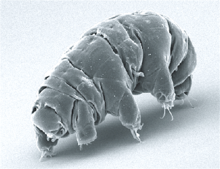
The list of tardigrades of South Africa is a list of species that form a part of the phylum Tardigrada of the fauna of South Africa. The list follows the SANBI listing.
Tardigrades (/ˈtɑːrdɪɡreɪdz/ ), known colloquially as water bears or moss piglets, are a phylum of eight-legged segmented micro-animals. They were first described by the German zoologist Johann August Ephraim Goeze in 1773, who called them Kleiner Wasserbär 'little water bear'. In 1776, the Italian biologist Lazzaro Spallanzani named them Tardigrada, which means 'slow walker'.
They live in diverse regions of Earth's biosphere – mountaintops, the deep sea, tropical rainforests, and the Antarctic. Tardigrades are among the most resilient animals known, with individual species able to survive extreme conditions – such as exposure to extreme temperatures, extreme pressures (both high and low), air deprivation, radiation, dehydration, and starvation – that would quickly kill most other forms of life. Tardigrades have survived exposure to outer space.
There are about 1,500 known species in the phylum Tardigrada, a part of the superphylum Ecdysozoa. The earliest known fossil is from the Cambrian, some 500 million years ago. They lack several of the Hox genes found in arthropods, and the middle region of the body corresponding to an arthropod's thorax and abdomen. Instead, most of their body is homologous to an arthropod's head.
Tardigrades are usually about 0.5 mm (0.02 in) long when fully grown. They are short and plump, with four pairs of legs, each ending in claws (usually four to eight) or sticky pads. Tardigrades are prevalent in mosses and lichens and can readily be collected and viewed under a low-power microscope, making them accessible to students and amateur scientists. Their clumsy crawling and their well-known ability to survive life-stopping events have brought them into science fiction and popular culture including items of clothing, statues, soft toys and crochet patterns. (Full article...)
Where common names are given, they are not necessarily the only common names in use for the species.
Class Heterotardigrada
Order Echiniscoidea
Family Echiniscidae
Genus Echiniscus:
- Echiniscus africanus Murray, 1907
- Echiniscus arctomys Ehrenberg, 1853
- Echiniscus crassispinosus Murray, 1907
- Echiniscus duboisi Richters, 1902
- Echiniscus longispinosus Murray, 1907
- Echlniscus perarmatus Murray, 1907
- Echiuiscus pusae Marcus, 1928
Genus Pseudechiniscus:
- Pseudechiniscus bispinosus (Murray, 1907)
- Pseudechiniscus jiroveci Bartos, 1963
- Pseudechiniscus suillus Ehrenberg, 1853), syn. Echiniscus mutabilis Murray, 1905, Pseudechiniscus suillus suillus (Ehrenberg, 1853)
Class Eutardigrada
Order Parachela
Family Hypsibiidae
Genus Doryphoribius:
- Doryphoribius flavus (Iharos, 1966), syn. Doryphoribius citrinus, (Maucci, 1972), Hypsibius citrinus Maucci, 1973
Genus Hypsibius:
- Hypsibius convergens (Urbanowicz, 1925), syn. Macrobiotus convergens Urbanowicz, 1925
- Hypsibius dujardini (Doyère, 1840), syn. Hypsibius lacustris (Doyère, 1851), Macrobiotus dujardin Doyère, 1840, Macrobiotus dujardini Doyère, 1840, Macrobiotus samoanus Richters, 1908
- Hypsibius maculatus (Iharos, 1969)
Genus Isohypsibius:
- Isohypsibius deconincki Pilato, 1971
- Isohypsibius nodosus (Murray, 1907), syn. Hypsibius nodosus (Murray, 1907), Macrobiotus nodosus Murray, 1907
- Isohypsibius sattleri (Richters, 1902), syn. Hypsibius bakonyiensis Iharos, 1964, Hypsibius sattleri (Richters, 1902), Isohypsibius bakonyiensis (Iharos, 1964), Macrobiotus sattleri Richters, 1902
Genus Ramazzottius:
- Ramazzottius szeptycki (Dastych, 1980), syn. Hypsibius szeptycki Dastych, 1980, Ramazzottius szepticki (Dastych, 1980)
- Ramazzottius theroni Dastych, 1983
Genus Diphascon:
- Diphascon scoticum Murray, 1905, syn. Adropion scoticum Murray, 1905, Hypsibius scoticus (Murray, 1905)
- Diphascon zaniewi Kaczmarek & Michalczyk, 2004
Genus Paradiphascon:
- Paradiphascon manningi Dastych, 1992
Genus Astatumen:
- Astatumen trinacriae (Arcidiacono, 1962), syn. Astatumen ramazzottii (Iharos, 1966), Itaquascon ramazzottii Iharos, 1966, Itaquascon trinacriae Arcidiacono, 1962
Family Calohypsibiidae
Genus Haplomacrobiotus:
- Haplomacrobiotus seductor Pilato & Beasley, 1987
Family Macrobiotidae
Genus Calcarobiotus:
- Calcarobiotus filmeri Dastych, 1993
- Calcarobiotus occultus Dastych, 1993
Genus Macrobiotus:
- Macrobiotus drakensbergi Dastych, 1993
- Macrobiotus echinogenitus Richters, 1904
- Macrobiotus furciger Murray, 1906, syn. Macrobiotus furciger Murray, 1907
- Macrobiotus hufelandi C.A.S. Schultze, 1834, syn. Macrobiotus eminens Ehrenberg, 1895, Macrobiotus hufelandii C.A.S. Schultze, 1834, Macrobiotus interruptus Della Valle, 1914
- Macrobiotus nuragicus Pilato & Sperlinga, 1975
- Macrobiotus richtersi Murray, 1911
- Macrobiotus iharosi Pilato, Binda & Catanzaro, 1991
- Macrobiotus crassidens (Murray, 1907)
Genus Minibiotus:
- Minibiotus hufelandioides (Murray, 1910), syn. Macrobiotus hufelandioides Murray, 1910
- Minibiotus intermedius (Plate, 1888), syn. Macrobiotus intermedius Plate, 1889, Macrobiotus intermedius intermedius]] Plate, 1889
Order Apochela
Family Milnesiidae
Genus Milnesium:
- Milnesium tardigradum Doyère, 1840, syn. Arcrophanes schlagintweitii Ehrenberg, 1859, Arctiscon tardigradum Schrank, 1803
References
- ^ "Checklist of South African Tardigrada. Animal checklist website". biodiversityadvisor.sanbi.org. South African National Biodiversity Institute. 2010. Retrieved 19 January 2021.